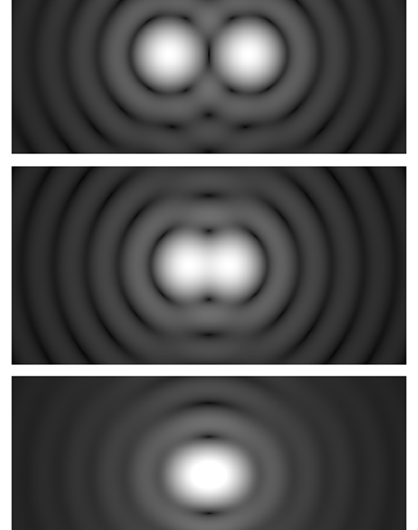September 5, 2016 report
Quantum mechanics technique allows for pushing past 'Rayleigh's curse'

(Phys.org)—A team of researchers with the National University of Singapore has found a way to get around what they describe as 'Rayleigh's curse'—a phenomenon that happens when two light sources appear to coalesce as they grow closer together, limiting the ability to measure the distance between them. In their paper published in the journal Physical Review Letters, the team describes how they applied a quantum mechanics technique to solve the problem.
For many years, scientists working in a variety of fields studying the stars through a telescope or objects through a microscope have been limited by the same problem—diffraction interfering with light sources that are very close together—the wave-like nature of light causes spreading, which in turn can cause an overlap of photons striking a surface meant to be used to measure the difference between two sources. Back in the late 1800's, John William Strutt, Lord Rayleigh, laid down the criterion to describe such limitations and it now bears his name. In this new effort, the researchers report on a new technique they have developed that gets around this problem, allowing for measuring the distance between light sources regardless of how far apart they are.
To address the diffraction problem, the researchers applied quantum metrology and quantum optics techniques, using a hybrid of quantum mechanics and a type of statistical theory—it involves working out which measurements are likely to give the most information when measuring sources of light—even when they violate the Rayleigh criterion. The result is an estimation, but one that is believed to be extremely accurate. In so doing, they have shown that 'Rayleigh's curse' is not an actual limit, but one that can be overcome. The work by the team follows an earlier effort using another technique and is different from other techniques that also overcome the Rayleigh limit that other teams have been reporting.
The researchers report that their technique is practical—devices using it will allow scientists to measure the distance between very close stars or very tiny objects that until now have not been discernable. One such area of research, they note, is fluorescence microscopy, which they believe should be a particularly good starting point.
More information: Mankei Tsang et al. Quantum Theory of Superresolution for Two Incoherent Optical Point Sources, Physical Review X (2016). DOI: 10.1103/PhysRevX.6.031033 , On Arxiv: arxiv.org/abs/1511.00552
ABSTRACT
Rayleigh's criterion for resolving two incoherent point sources has been the most influential measure of optical imaging resolution for over a century. In the context of statistical image processing, violation of the criterion is especially detrimental to the estimation of the separation between the sources, and modern far-field superresolution techniques rely on suppressing the emission of close sources to enhance the localization precision. Using quantum optics, quantum metrology, and statistical analysis, here we show that, even if two close incoherent sources emit simultaneously, measurements with linear optics and photon counting can estimate their separation from the far field almost as precisely as conventional methods do for isolated sources, rendering Rayleigh's criterion irrelevant to the problem. Our results demonstrate that superresolution can be achieved not only for fluorophores but also for stars.
Journal information: Physical Review Letters , Physical Review X , arXiv
© 2016 Phys.org




















